Introduced to the Formula 1 calendar in 2008, the Singapore Grand prix was revolutionary with its intriguing combination of the night-time lights and public roads. At just over 5km, the Marina Bay circuit sweeps through the heart of the city and requires a high downforce package to combat the tight, often 90°, corners.
The #F1nightrace week is finally here! 5 days to #SingaporeGP ? pic.twitter.com/9D7gI4hEq8
— SingaporeGP (@F1NightRace) September 12, 2017
Power Unit Notes
The Marina Bay circuit has two short straights: the 500m pit straight and then the curved straight between turns five and seven, which shoots down Raffles Boulevard. This 700m straight is the only time the driver will get over the 300kph mark. Although kerbs are used extensively here, the majority are relatively flat.
The long lap and the high chance of a safety car makes Singapore one of the longest races on the calendar. The 2009 race was the shortest so far, at one hour and 56 minutes.
Fuel consumption in Singapore is high due to the stop-start nature of the track layout. Using the ICE alone, the engine would consume around 150kg of fuel over the race, but energy harvesting and employment has brought this down to under 105kg.
The drivers can lose up to 3kg of fluid during the race in the hot and humid atmosphere. This needs to be taken into account when setting the car weight before the race.
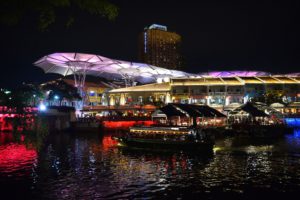 Singapore is one of the slowest circuits on the calendar, rating just above Monaco and Hungary in terms of the lowest average speed. With 23 corners, the average speed is around 175kph
Singapore is one of the slowest circuits on the calendar, rating just above Monaco and Hungary in terms of the lowest average speed. With 23 corners, the average speed is around 175kph
- There are 82 gear changes per lap as opposed to just 52 in Monaco and just 44 in Monza. Due to the short bursts of power, eighth gear will only be engaged two times per lap. Only Monaco has a lower usage.
- In Singapore the ambient humidity can be well over 80%. In the past, these conditions would have had a big impact on the power output, which decreases as less oxygen is available to burn. With the turbo engines, however, the turbo compensates for the lack of oxygen by spinning at a higher rate. In fact, it will spin considerably faster than a comparable race run in dry conditions.
- The big stops on the lap are Turn 7 and 14 where the driver will brake from 300 to 110kph.
- There are few long straights and lots of opportunities to recover energy on braking via the MGU-K. The K may actually be used to propel the car to a higher torque level than usual allowing us to save fuel at this circuit, which is notoriously difficult on fuel consumption.
- Running in the evening will see the relative humidity reduce as the sun goes down. The electrical components of the PU will therefore be insulated against moisture and, in case of rain, the water will be diverted away using special ducts.
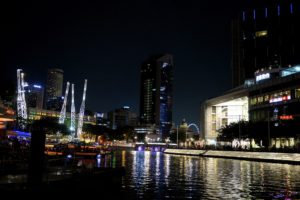 In Numbers
In Numbers
18 – According to research by the British Council, Singaporeans are the fastest walkers on earth. On average they walk 18 metres in 10.55 seconds or 6.15km an hour.
63 – Singapore is made up of 63 islands.
280 – Due to busy air traffic, buildings in Singapore can be no higher than 280 metres.
682.7 – At 682.7 square kilometres, Singapore is one of the smallest countries in the world.
Race
2017 Formula 1 Singapore Airlines Singapore Grand Prix
Circuit name Marina Bay Circuit
First race 2008
Previous winners
2016 Nico Rosberg, 61 laps, 1:55:48.950s
2015 Sebastian Vettel
2014 Lewis Hamilton
History lesson The Singapore Grand Prix celebrates its 10th anniversary this year. First run in 2008, the race takes place at night and sees the cars run through downtown Singapore under floodlights. It’s a breathtaking spectacle. But motor racing isn’t new to the city-state; there was a non-championship Singapore Grand Prix on the Thomson Road street circuit between 1961 and ’73
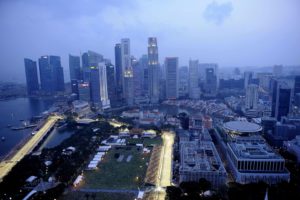 Travel
Travel
City Singapore
Time zone BST+7 / CET+6
Population 4.5 million
Getting there The sea freight, which includes a lot of garage equipment, arrived at the Marina Bay Circuit last week and the air freight arrived over the weekend. The mechanics arrived on Monday, with the engineers, management and drivers touching down later in the week
Surprising fact Singapore is one of only three city-states in the world, the others being Monaco and Vatican City
Local speciality There are many culinary delights in Singapore, one of which is carrot cake. However, this hawker staple is neither a cake nor made of carrot. It’s a white radish omelette, in which a gnocchi-like dough made from grated turnip, rice and tapioca flour is stir-fried with scrambled eggs and lots of garlic. Travel writers have described it as Singapore’s answer to a kebab, but no-one seems able to shed light on why it’s called carrot cake
Weather Hot and humid. Temperatures hover around 30 degrees in the day, with 80 per cent humidity. Thunderstorms occur regularly, but there has yet to be a wet Singapore Grand Prix
 Track
Track
Track length 5.065km/3.148 miles (13th longest track of the year – longest: Spa-Francorchamps, shortest: Monaco)
2016 pole position Nico Rosberg, 1m42.584s
2016 fastest lap Daniel Ricciardo, 1m47.187s (lap 49)
Lap record 1:47.187s (Daniel Ricciardo, 2016)
Tyre choice Purple Ultrasoft, red Supersoft and yellow Soft – the seventh time this combination has been used in 2017
Distance to Turn One 200m/0.124 miles (longest of season: Barcelona 730m/0.454 miles)
Longest straight 832m/0.517 miles, on the approach to Turn Seven (longest of the season: Baku, 2.1km/1.305 miles)
Top speed 305km/h/190mph, on the approach to Turn One (fastest of season: Monza, 360km/h/224mph)
Full throttle 47 per cent (highest of the season: Monza, 75 per cent). The longest period of uninterrupted full throttle is just 9s
Brakewear High. There are 16 braking events around the lap and few straights along which to cool the brakes
Fuel consumption 1.9kg per lap, which is relatively high and comes as a result of the stop-start nature of the track
ERS demands Medium. There are lots of demands on the ERS, but plenty of opportunities to harvest energy under braking
Gear changes 80 per lap/4,880 per race – the highest of the season
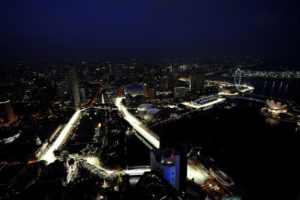 Race
Race
Laps 61 laps
Start time 20:00hrs local / 13:00hrs BST / 14:00 CET
Grid advantage It’s a short dash to Turn One, but there’s a definite grip advantage on the racing line. With that in mind, pole position is located on the outside of the track
DRS There are two DRS zones, on the approaches to Turns One and Seven
Don’t put the kettle on… Qualifying is always spectacular under the lights and the start of the race is crucial because overtaking is difficult. A lot can be won and lost in the opening 200 metres/0.124 miles. The firework display as the cars take the chequered flag is something not to be missed either
Pitlane length/Pitstops 420m/0.261 miles (longest of the season: Silverstone, 457m/0.283 miles). It’s a long and slow pitlane at Marina Bay, with a speed limit of just 60km/h/37mph. It takes 29s to make a stop, which is the longest of the season
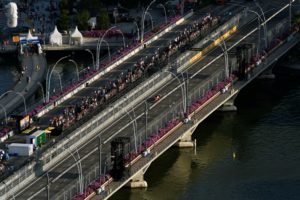 Safety Car likelihood 100 per cent. There has been at least one Safety Car period in every Singapore Grand Prix. It’s something that teams factor into their race strategies
Safety Car likelihood 100 per cent. There has been at least one Safety Car period in every Singapore Grand Prix. It’s something that teams factor into their race strategies
Watch out for… Rain. This is the 10th Singapore Grand Prix and there has yet to be a wet race. Question marks about how the artificial lights affect visibility in spray will only be answered when there’s a wet race. Also, look out for the right-left chicane at Turns 20/21. The cars accelerate onto the start finish straight from here and the drivers are eager to get the power down early
IT’S RACE WEEK ?
The heat is on in the title race ??
Time to stay cool ?#SingaporeGP #F1NightRace pic.twitter.com/FZSsetmtSd
— Formula 1 (@F1) September 11, 2017
































